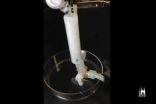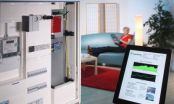(Press-News.org) Because people in developed countries spend about 90% of their time indoors, their sense of warmth becomes one key comfort factor for interior spaces. VTT Technical Research Centre of Finland has developed a new method for assessing the individual thermal comfort experienced by different user groups. The design of energy efficient buildings – such as day care centres, schools, offices and homes for the elderly – should pay more attention in future to the thermal comfort of user groups according to real needs.
The new method developed for assessing thermal comfort (Human Thermal Model, HTM) is based on modelling of individual anatomy and physiology. The method can be used to assess the impact of individual characteristics – gender, age, body mass index and muscularity – on the volumes of various tissue types (bone, muscle, fat and skin).
The heat and moisture transfer between a person's anatomy, clothing and the environment determine the local temperature of body tissues. These temperature values can be used to calculate the local thermal comfort of different parts of the body.
An adequately precise identification of the various body tissues is important because muscle tissue, for example, when at rest produces heat at a basal metabolic rate of 0.67 W/kg, while the heat produced by fat tissue is at a rate of 0.004 W/kg. Light office work produces just over 2W of thermal power per kilo of muscle, while cleaning work produces 5W and strenuous sporting performance momentarily over 20W.
When comparing the thermal comfort of women and men using same values for all other individual characteristics (body mass and muscle indexes), the indexes for male thermal comfort were on average 0.39 units higher than for women in the case of 20-year-olds and 80-year-olds, and 0.48 units higher for 50-year-olds.
Several previous researches have shown men to have statistically more muscle tissue on average than women. People also lose muscle mass as they grow older. Because the thermal output of muscle tissue per kilogram is several orders of magnitude higher than that of fat tissue, it is important to be aware about individual amount of muscle tissue. Thus gender and individual muscularity in particular out of the various characteristics have a considerable impact on metabolic rate and tissue temperature – and in the end on the person's thermal comfort.
One mega trend in the coming years will be continuous improvement in the energy efficiency of existing and new construction. From occupant point of view it will important to be able to estimate thermal comfort of different end user groups, so that relevant design and maintenance solutions would ensure simultaneous fulfilment of both energy efficiency and satisfaction with thermal conditions.
The impact of individual human characteristics on thermal comfort will be presented in June at the Building Simulation and Optimisation 2014 conference in London, as well as at other venues.
INFORMATION:
For further information, please contact:
VTT Technical Research Centre of Finland
Principal Scientist, D.Sc. (Tech.)
Pekka Tuomaala
pekka.tuomaala@vtt.fi
Further information on VTT:
Olli Ernvall
Senior Vice President, Communications
358 20 722 6747
olli.ernvall@vtt.fi
http://www.vtt.fi
VTT Technical Research Centre of Finland
VTT is a leading multitechnological applied research organization in Northern Europe. VTT creates new technology and science-based innovations in co-operation with domestic and foreign partners. Every third Finnish technology innovation contains VTT expertise. VTT's turnover is EUR 310 million and its personnel totals 2,900.
VTT: Building to take note of individual human thermal comfort
Gender and muscularity decisive -- women feel the cold more than men
2014-03-25
ELSE PRESS RELEASES FROM THIS DATE:
Simple, like a neutron star
2014-03-25
In how many ways can one describe an object? Take an apple: by just looking at it we can easily estimate its weight, shape and colour but we are unable to describe it at any other level, for example, to evaluate the chemical composition of its flesh. Something similar also applies to astronomical objects: until today one of the challenges facing scientists was to describe neutron stars at the nuclear physics level. The matter these stars are made up of is in fact extremely complex, and several complicated equations of state have been proposed. However, to date there is ...
New technique brings us closer to HIV and Hepatitis C vaccines
2014-03-25
Plans for a new type of DNA vaccine to protect against the deadly HIV and Hepatitis C viruses have taken an important step forward, with University of Adelaide researchers applying for a patent based on groundbreaking new research.
Professor Eric Gowans from the University's Discipline of Surgery, based at the Basil Hetzel Institute at the Queen Elizabeth Hospital, has submitted a patent application for what he describes as a relatively simple but effective technique to stimulate the body's immune system response, thereby helping to deliver the vaccine.
While pre-clinical ...
Catheter innovation destroys dangerous biofilms
2014-03-25
DURHAM, N.C. -- For the millions of people forced to rely on a plastic tube to eliminate their urine, developing an infection is nearly a 100 percent guarantee after just four weeks. But with the help of a little bubble-blowing, biomedical engineers hope to bring relief to urethras everywhere.
About half of the time, the interior of long-term urinary catheters become plagued by biofilms -- structures formed by colonies of bacteria that are extremely difficult to kill. Once established, it is only a matter of time before the biofilm becomes a welcoming host for other, ...
Doxorubicin alone or with ifosfamide for treating soft tissue sarcoma?
2014-03-25
An EORTC study published in The Lancet Oncology does not support administration of intensified doxorubicin and ifosfamide for palliation of advanced soft tissue sarcoma, unless the objective is to shrink the tumor.
Dr. Ian Judson of the Royal Marsden Hospital in London and coordinator of this study says, "Our clinical trial was designed to compare combination treatment with doxorubicin and ifosfamide to treatment with doxorubicin alone, and our results show that the combination chemotherapy did not improve overall survival. So, if the goal of treatment is to control the ...
Leading surgeons warn against media hype about tracheal regeneration
2014-03-25
Beverly, MA, March 24, 2014 – Reports of the two earliest tissue-engineered whole organ transplants using a windpipe, or trachea, created using the patient's own stem cells, were hailed as a breakthrough for regenerative medicine and widely publicized in the press. However, two leading transplant surgeons in Belgium warn of the dangers of media attention, and urge that tracheal bioengineering be demonstrated as both effective and safe before further transplants take place. Their views are published in an Editorial in The Journal of Thoracic and Cardiovascular Surgery, an ...
Research study takes deeper look at the role of gut microbes in the immune system
2014-03-25
LOS ANGELES (March 24, 2014) – New research suggests that gut microorganisms do not merely influence immune cell function, but also support the production of immune cells that form the first line of defense against infection. By understanding the mechanisms responsible for maintaining and replacing immune cells, researchers hope to one day develop targeted therapies to support and boost immune function in humans.
Study investigators from the Regenerative Medicine Institute at Cedars-Sinai collaborated with the Mount Sinai School of Medicine and lead institution — the ...
Replacing insulin through stem cell-derived pancreatic cells under the skin
2014-03-25
LA JOLLA, Calif., March 25, 2014 – Sanford-Burnham Medical Research Institute (Sanford-Burnham) and UC San Diego School of Medicine scientists have shown that by encapsulating immature pancreatic cells derived from human embryonic stem cells (hESC), and implanting them under the skin in animal models of diabetes, sufficient insulin is produced to maintain glucose levels without unwanted potential trade-offs of the technology. The research suggests that encapsulated hESC-derived insulin-producing cells hold great promise as an effective and safe cell-replacement therapy ...
Complex brain functional network connection after stroke
2014-03-25
Studies have shown that functional network connection models can be used to study brain network changes in patients with schizophrenia. A research team from Huazhong University of Science and Technology in China inferred that these models could also be used to explore functional network connectivity changes in stroke patients. The researchers used independent component analysis to find the motor areas of stroke patients, which is a novel way to determine these areas. Functional magnetic resonance imaging datasets were collected from healthy controls and right-handed stroke ...
Technofossils -- an unprecedented legacy left behind by humans
2014-03-25
A new study by an international team of scientists, including Dr Jan Zalasiewicz and Professor Mark Williams of the University of Leicester's Department of Geology, suggests that the fossil impact humans have made on the planet is vast and unprecedented in nature – and that there's been nothing remotely like it since the Earth formed, over four and half billion years ago.
The study, entitled 'The technofossil record of humans' and published by SAGE in The Anthropocene Review, argues that, like dinosaurs, who left their bones and footprints behind for future generations ...
Managing renewables intelligently
2014-03-25
"Wind, solar and biogas are all energy sources with their own strengths and weaknesses. And it's by combining the strengths of each in a smart way that we'll be able to guarantee Germany's energy supply into the future," says Dr. Kurt Rohrig, deputy director of the Fraunhofer Institute for Wind Energy and Energy System Technology IWES in Kassel. But what happens when, instead of a big power plant, you have a host of individual small energy producers feeding in energy to the grid at varying times? Is reliable operation of the grid still technically feasible? In the "Combined ...
LAST 30 PRESS RELEASES:
Pandemic ‘beneath the surface’ has been quietly wiping out sea urchins around the world
Tea linked to stronger bones in older women, while coffee may pose risks
School feeding programs lead to modest but meaningful results
Researchers develop AI Tool to identify undiagnosed Alzheimer's cases while reducing disparities
Seaweed based carbon catalyst offers metal free solution for removing antibiotics from water
Simple organic additive supercharges UV treatment of “forever chemical” PFOA
£13m NHS bill for ‘mismanagement’ of menstrual bleeds
The Lancet Psychiatry: Slow tapering plus therapy most effective strategy for stopping antidepressants, finds major meta-analysis
Body image issues in adolescence linked to depression in adulthood
Child sexual exploitation and abuse online surges amid rapid tech change; new tool for preventing abuse unveiled for path forward
Dragon-slaying saints performed green-fingered medieval miracles, new study reveals
New research identifies shared genetic factors between addiction and educational attainment
Epilepsy can lead to earlier deaths in people with intellectual disabilities, study shows
Global study suggests the underlying problems of ECT patients are often ignored
Mapping ‘dark’ regions of the genome illuminates how cells respond to their environment
ECOG-ACRIN and Caris Life Sciences unveil first findings from a multi-year collaboration to advance AI-powered multimodal tools for breast cancer recurrence risk stratification
Satellite data helps UNM researchers map massive rupture of 2025 Myanmar earthquake
Twisting Spins: Florida State University researchers explore chemical boundaries to create new magnetic material
Mayo Clinic researchers find new hope for toughest myeloma through off-the-shelf immunotherapy
Cell-free DNA Could Detect Adverse Events from Immunotherapy
American College of Cardiology announces Fuster Prevention Forum
AAN issues new guideline for the management of functional seizures
Could GLP-1 drugs affect risk of epilepsy for people with diabetes?
New circoviruses discovered in pilot whales and orcas from the North Atlantic
Study finds increase in risk of binge drinking among 12th graders who use 2 or more cannabis products
New paper-based technology could transform cancer drug testing
Opioids: clarifying the concept of safe supply to save lives
New species of tiny pumpkin toadlet discovered in Brazil highlights need for conservation in the mountain forests of Serra do Quiriri
Reciprocity matters--people were more supportive of climate policies in their country if they believed other countries were making significant efforts themselves
Stanford Medicine study shows why mRNA-based COVID-19 vaccines can cause myocarditis
[Press-News.org] VTT: Building to take note of individual human thermal comfortGender and muscularity decisive -- women feel the cold more than men

